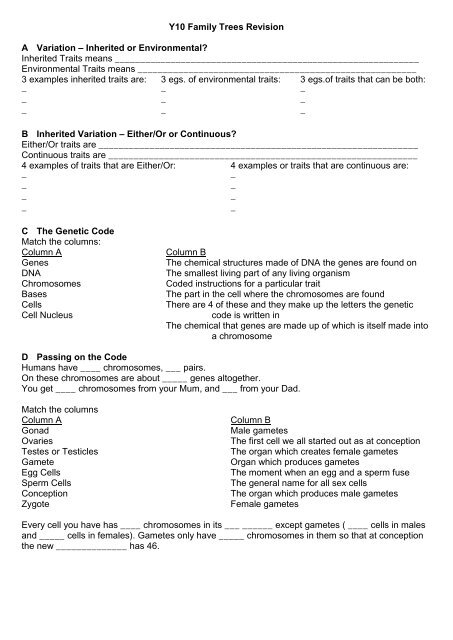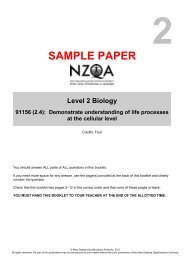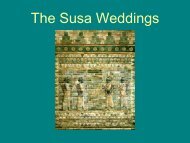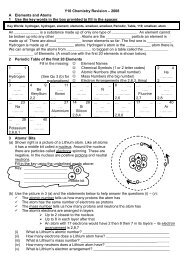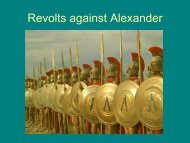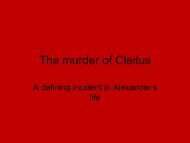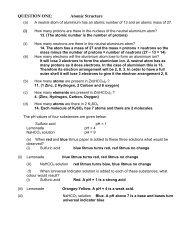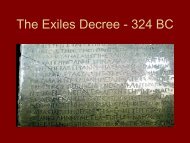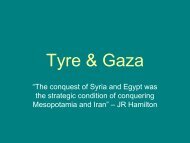Y10 Family Trees Revision A Variation â Inherited or Environmental ...
Y10 Family Trees Revision A Variation â Inherited or Environmental ...
Y10 Family Trees Revision A Variation â Inherited or Environmental ...
Create successful ePaper yourself
Turn your PDF publications into a flip-book with our unique Google optimized e-Paper software.
<strong>Y10</strong> <strong>Family</strong> <strong>Trees</strong> <strong>Revision</strong><br />
A <strong>Variation</strong> – <strong>Inherited</strong> <strong>or</strong> <strong>Environmental</strong>?<br />
<strong>Inherited</strong> Traits means ____________________________________________________________<br />
<strong>Environmental</strong> Traits means _______________________________________________________<br />
3 examples inherited traits are: 3 egs. of environmental traits: 3 egs.of traits that can be both:<br />
<br />
<br />
<br />
B <strong>Inherited</strong> <strong>Variation</strong> – Either/Or <strong>or</strong> Continuous?<br />
Either/Or traits are _______________________________________________________________<br />
Continuous traits are _____________________________________________________________<br />
4 examples of traits that are Either/Or: 4 examples <strong>or</strong> traits that are continuous are:<br />
<br />
<br />
<br />
<br />
<br />
<br />
<br />
<br />
C The Genetic Code<br />
Match the columns:<br />
Column A<br />
Genes<br />
DNA<br />
Chromosomes<br />
Bases<br />
Cells<br />
Cell Nucleus<br />
Column B<br />
The chemical structures made of DNA the genes are found on<br />
The smallest living part of any living <strong>or</strong>ganism<br />
Coded instructions f<strong>or</strong> a particular trait<br />
The part in the cell where the chromosomes are found<br />
There are 4 of these and they make up the letters the genetic<br />
code is written in<br />
The chemical that genes are made up of which is itself made into<br />
a chromosome<br />
D Passing on the Code<br />
Humans have ____ chromosomes, ___ pairs.<br />
On these chromosomes are about _____ genes altogether.<br />
You get ____ chromosomes from your Mum, and ___ from your Dad.<br />
Match the columns<br />
Column A<br />
Gonad<br />
Ovaries<br />
Testes <strong>or</strong> Testicles<br />
Gamete<br />
Egg Cells<br />
Sperm Cells<br />
Conception<br />
Zygote<br />
Column B<br />
Male gametes<br />
The first cell we all started out as at conception<br />
The <strong>or</strong>gan which creates female gametes<br />
Organ which produces gametes<br />
The moment when an egg and a sperm fuse<br />
The general name f<strong>or</strong> all sex cells<br />
The <strong>or</strong>gan which produces male gametes<br />
Female gametes<br />
Every cell you have has ____ chromosomes in its ___ ______ except gametes ( ____ cells in males<br />
and _____ cells in females). Gametes only have _____ chromosomes in them so that at conception<br />
the new ______________ has 46.
E Passing Genes From Cell to Cell – Cell Division<br />
There are 2 kinds of cell division – their names are Mitosis (“My Toe Sis”) and<br />
Meiosis (“My Owe Sis”).<br />
Label each diagram with the c<strong>or</strong>rect name f<strong>or</strong> the kind of cell division shown:<br />
Type of Cell Division:<br />
________________<br />
46<br />
chromosomes<br />
46 92<br />
All chromosomes<br />
replicated (copied) – now<br />
92 chromosomes<br />
46<br />
46<br />
Cell splits into 2<br />
new “daughter”<br />
cells – each with 46<br />
chromosomes<br />
which are identical<br />
to the <strong>or</strong>iginal cell<br />
Start with 46, end<br />
with 2 cells with 46.<br />
23<br />
Type of Cell Division:<br />
________________ 46 92<br />
Start with 46, end<br />
with 4 cells with 23.<br />
46<br />
46<br />
23<br />
23<br />
23<br />
46 chromosomes replicate (92) divide (2 x 46) divide again (4 x 23)<br />
no replicating<br />
__________ is the type of cell division involved with growth and repair. Four types of cell it occurs in<br />
are: ______________, ___________________, _______________ and _____________.<br />
__________ is the type of cell division which creates _______. Type types of cell created by Meiosis<br />
are ___________ cells and _________ cells.<br />
F Types of Reproduction – Sexual <strong>or</strong> Asexual?<br />
_______ reproduction involves 1 parent only. The offspring are all _________ to the parent.<br />
3 examples of asexual reproduction are: ___________, ___________ and ____________.<br />
_______ requires 2 parents. The offspring are always a combination of the traits of the parents <strong>or</strong><br />
earlier ancest<strong>or</strong>s. An example of sexual reproduction is ___________.<br />
Advantages of asexual reproduction: ____________, ___________<br />
Disadvantage:<br />
____________<br />
Advantages of sexual reproduction: ____________, ___________, ____________<br />
Disadvantage:<br />
___________, _____________<br />
When a population of individuals has only some of them surviving because only some of the<br />
individuals have the traits which equip them to survive certain conditions we call this _______<br />
Selection. Why does this make a population change over time? ________________________
G Sex Determination – Boy <strong>or</strong> Girl?<br />
Your sex is determined by a pair of chromosomes called your ___ chromosomes.<br />
There are 2 types of sex chromosome – _____ and _____.<br />
The chromosome pair f<strong>or</strong> girls is ______. The chromosome pair f<strong>or</strong> boys ______.<br />
Explain why it’s the Dad’s fault if the children they always have is a particular sex (eg only boys when<br />
they wanted some girls too) _________________________________________________________.<br />
H Genetics Terms<br />
Match the columns:<br />
Column A<br />
Gene<br />
Allele<br />
Genotype<br />
Phenotype<br />
Dominant<br />
Recessive<br />
Heterozygous<br />
Homozygous Recessive<br />
Homozygous Dominant<br />
F1 Offspring<br />
F2 Offspring<br />
Column B<br />
An allele which shows up even if paired with a different allele<br />
A genotype made up of a pair of different alleles<br />
The code f<strong>or</strong> a particular trait (eg eye colour)<br />
A genotype made up of a pair of dominant alleles<br />
The pair of alleles you have<br />
An allele which only shows up if paired with another the same<br />
Children<br />
<strong>Variation</strong>s of a gene (eg brown eyes, blue eyes)<br />
A genotype made up of a pair of recessive alleles<br />
Grandchildren<br />
What you see f<strong>or</strong> a particular genotype<br />
I Predicting What the Offspring Could Be – Punnett Squares<br />
Example: Curly <strong>or</strong> Straight Haired Guinea Pigs?<br />
The allele f<strong>or</strong> curly hair in guinea pigs (C) is dominant and the allele f<strong>or</strong> straight hair (c) is recessive.<br />
A guinea pig breeding pair have the following characteristics – The Dad (Fang) has straight hair but<br />
the Mum (Moose) is heterozygous.<br />
(a) What is Fang’s genotype and what do we call it? ____, __________________________.<br />
(b) What is Moose’s genotype and phenotype? ____, ______________________________.<br />
(c) Fill in the Punnett Square shown below (be sure to include the possible phenotypes in each box)<br />
to see what the possibilities are f<strong>or</strong> Fang and Moose’s offspring (babies):<br />
Moose<br />
_____ _____<br />
Fang<br />
_____<br />
_____<br />
(d) What prop<strong>or</strong>tions of possible Cc : cc? _______________________________________________<br />
(e) What are the prop<strong>or</strong>tions of possible Curly Haired to Straight Haired babies? ________________<br />
(f) Explain why there could never be any homozygous dominant babies? _____________________<br />
(g) Explain why all of Fang and Moose’s babies might end up being Straight Haired<br />
_____________________________________________________________________________<br />
(h) Ripper and Petal are another breeding pair. They are both Curly Haired. One of their babies is<br />
Straight Haired. Discuss what this tells about Ripper and Petal’s genotypes<br />
_____________________________________________________________________________<br />
_____________________________________________________________________________<br />
_____________________________________________________________________________<br />
_____________________________________________________________________________<br />
_____________________________________________________________________________<br />
_____________________________________________________________________________
Answers<br />
A You got it off a parent <strong>or</strong> ancest<strong>or</strong><br />
I (a) cc, homozygous recessive<br />
You got it from something that happened to you (not (b) Cc, curly hair<br />
inherited) (c) Moose<br />
<strong>Inherited</strong>: <strong>Environmental</strong> Both – just about<br />
C<br />
c<br />
eye colour, skin Scars, tattoos, anything<br />
colour, hair colour piercings, injuries nowadays<br />
c Cc<br />
cc<br />
hair wavyness,etc plastic surgery,etc<br />
Fang<br />
Curly Straight<br />
B traits which have only 2 <strong>or</strong> a few specific possibilities<br />
Traits which have a continuous range of possibilities<br />
c Cc<br />
Curly<br />
cc<br />
Straight<br />
Either/Or Continuous (d) 2 Cc : 2 cc <strong>or</strong>, ½ Cc to ½ cc <strong>or</strong> 50% Cc to 50% cc<br />
Tongue roller Height <strong>or</strong> 1Cc : 1 cc<br />
Widow’s Peak Weight (e) 2 curly : 2 straight, <strong>or</strong> ½ curly to ½ straight, <strong>or</strong><br />
Earlobe shape Length of any particular 50% curly to 50% straight, <strong>or</strong> 1 curly : 1 straight<br />
Blood Group bone in the body (f) to get homozygous dominant (CC) the baby needs to<br />
get a C from each parent – Fang hasn’t got any C’s<br />
C<br />
(g) the chances are always 50:50 f<strong>or</strong> each baby so<br />
any baby always has a chance of being straight.<br />
(h) This tells us they both have Cc.<br />
We know this because to get a straight haired baby<br />
it must have a genotype cc since c is recessive and<br />
only shows up when the genotype is a pair of c’s.<br />
D 46 23 70000 23 23<br />
The baby only gets 1 c from each parent so they<br />
must both have one to give.<br />
Since both parents have the curly haired phenotype<br />
and the genotype f<strong>or</strong> curly can be either CC <strong>or</strong> Cc<br />
(because the allele f<strong>or</strong> curly is the dominant C),<br />
their other allele must be C, giving Cc.<br />
46 cell nucleus sperm egg 23 zygote<br />
E Mitosis<br />
Meiosis<br />
Mitosis. skin, hair follicle, stomach lining, blood, growing<br />
baby (any 4 answers)<br />
Meiosis gametes <strong>or</strong> sex cells. sperm egg (either <strong>or</strong>der)<br />
F Asexual identical budding, cloning, cuttings, grafting<br />
Sexual reproduction in mammals, flowering plants,<br />
Birds, fish, lizards, insects, etc<br />
Quick, simple<br />
Since all offspring identical then all could die from the<br />
Same disease <strong>or</strong> conditions – all could easily die<br />
<strong>Variation</strong> in the population, some could be tolerant to a<br />
disease <strong>or</strong> conditions, can identify each other<br />
Natural. The individuals which can’t tolerate a disease<br />
<strong>or</strong> conditions don’t survive to breed – those which<br />
can do survive to breed<br />
G sex. X Y (either <strong>or</strong>der). XX XY. Egg cells can only<br />
X, sperm cells can have X <strong>or</strong> Y so it’s sperm cells<br />
which make a baby be XX <strong>or</strong> XY.<br />
H


